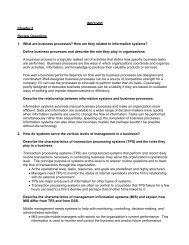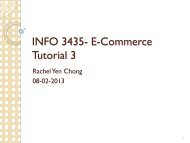eCommerce business models and concepts - Home
eCommerce business models and concepts - Home
eCommerce business models and concepts - Home
You also want an ePaper? Increase the reach of your titles
YUMPU automatically turns print PDFs into web optimized ePapers that Google loves.
INFO 3435 <strong>eCommerce</strong>2. <strong>eCommerce</strong> BusinessModels <strong>and</strong> ConceptsAlex<strong>and</strong>er Nikov
Teaching Objectives• Identify the key components of <strong>eCommerce</strong> <strong>business</strong> <strong>models</strong>.• Describe the major B2C <strong>business</strong> <strong>models</strong>.• Describe the major B2B <strong>business</strong> <strong>models</strong>.• Describe <strong>business</strong> <strong>models</strong> in other emerging areas of<strong>eCommerce</strong>.• Explain the key <strong>business</strong> <strong>concepts</strong> <strong>and</strong> strategies applicableto <strong>eCommerce</strong>.2-2
Tweet Tweet:What’s Your Business Model?• What characteristics or benchmarks can be usedto assess the <strong>business</strong> value of a company suchas Twitter?• Have you used Twitter to communicate withfriends or family? What are your thoughts on thisservice?• What are Twitter’s most important assets?• Which of the various methods described formonetizing Twitter’s assets do you feel might bemost successful?2-3
Outline1. <strong>eCommerce</strong> Business Models2. Major Business-to-Consumer (B2C) Business Models3. Major Business-to-Business (B2B) Business Models4. Business Models in Emerging <strong>eCommerce</strong> Areas5. How the Internet <strong>and</strong> the Web Change Business: Strategy,Structure, <strong>and</strong> Process2-4
Components of eBusiness <strong>models</strong>2-5
<strong>eCommerce</strong> Business Models• Business model– Set of planned activities designed to result ina profit in a marketplace• Business plan– Describes a firm’s <strong>business</strong> model• <strong>eCommerce</strong> <strong>business</strong> model– Uses/leverages unique qualities of Internet<strong>and</strong> Web2-6
8 Key Elements of a Business Model2-7
1. Value Proposition• Why should the customer buy from you?• Successful <strong>eCommerce</strong> value propositions:– Personalization/customization– Reduction of product search, price discovery costs– Facilitation of transactions by managing productdelivery2-8
2. Revenue Model• How will the firm earn revenue, generate profits,<strong>and</strong> produce a superior return on investedcapital?• Major types:– Advertising revenue model– Subscription revenue model– Transaction fee revenue model– Sales revenue model– Affiliate revenue model2-9
Advertising Revenue Model• Web site that offers content, services <strong>and</strong>/or productsalso provides a forum for advertisements <strong>and</strong>receives fees from advertisers• Example: Yahoo.com2-10
Subscription Revenue Model• Web site that offers users content or services chargesa subscription fee for access to some or all of itsofferings• Examples:• Consumer Reports Online• Yahoo! Platinum2-11
Ancestry.com Uses a Subscription Business Model2-12
Transaction Fee Revenue Model• Company that receives a fee for enabling or executinga transaction• Examples:• eBay.com• E-Trade.com2-13
Sales Revenue Model• Company derives revenue by selling goods,information, or services to customers• Examples:• Amazon.com• LLBean.com• Gap.com2-14
Amazon Uses a Sales Revenue Model2-15
Affiliate Revenue Model• Sites that steer <strong>business</strong> to an “affiliate” receive a referralfee or percentage of the revenue from any resulting sales• Example:• MyPoints.com2-16
Five Primary Revenue Models2-17
3. Market Opportunity• What marketspace do you intend to serve <strong>and</strong> what is itssize?– Marketspace: Area of actual or potential commercialvalue in which company intends to operate– Realistic market opportunity: Defined by revenuepotential in each of market niches in which companyhopes to compete• Market opportunity typically divided into smallerniches2-18
Marketspace <strong>and</strong> Market Opportunity in theSoftware Training Market2-19
4. Competitive Environment• Who else occupies your intended marketspace?– Other companies selling similar products in the samemarketspace– Includes both direct <strong>and</strong> indirect competitors• Influenced by:– Number <strong>and</strong> size of active competitors– Each competitor’s market share– Competitors’ profitability– Competitors’ pricing2-20
Competitive Environment (cont’d)• Direct competitors – companies that sell products orservices that are very similar <strong>and</strong> into the same marketsegment• Example: Priceline.com <strong>and</strong> Travelocity.com• Indirect competitors – companies that may be in differentindustries but that still compete indirectly because theirproducts can substitute for one another• Example: CNN.com <strong>and</strong> ESPN.com2-21
5. Competitive Advantage• What special advantages does your firm bring tothe marketspace?– Achieved when firm produces superior product orcan bring product to market at lower price thancompetitors• Important <strong>concepts</strong>:– Asymmetries– First-mover advantage– Unfair competitive advantage– Leverage– Perfect markets2-22
Competitive Advantage (cont’d)• Asymmetries - when one participant in a market hasmore resources than others• First mover advantage – results from a firm being firstinto a marketplace• Unfair competitive advantage – occurs when one firmdevelops an advantage based on a factor that other firmscannot purchase• Companies leverage their competitive assets when theyuse their competitive advantages to achieve moreadvantage in surrounding markets2-23
6. Market Strategy• How do you plan to promote your products or services toattract your target audience?– Details how a company intends to enter market <strong>and</strong>attract customers– Best <strong>business</strong> <strong>concepts</strong> will fail if not properlymarketed to potential customers2-24
7. Organizational Development• What types of organizational structures within the firmare necessary to carry out the <strong>business</strong> plan?• Describes how firm will organize work– Typically divided into functional departments– Hiring moves from generalists to specialists ascompany grows2-25
8. Management Team• What kinds of experiences <strong>and</strong> backgroundshould thecompany’s leaders have?– Employees are responsible for making the <strong>business</strong>model work– Strong management team gives instant credibility tooutside investors• A strong management team:– Can make the <strong>business</strong> model work– Can give credibility to outside investors– Has market-specific knowledge– Has experience in implementing <strong>business</strong> plans2-26
Categorizing <strong>eCommerce</strong> Business Models• No one correct way• We categorize <strong>business</strong> <strong>models</strong> according to:– <strong>eCommerce</strong> sector (B2C, B2B, C2C)– Type of <strong>eCommerce</strong> technology; i.e., m-commerce• Similar <strong>business</strong> <strong>models</strong> appear in more thanone sector• Some companies use multiple <strong>business</strong> <strong>models</strong>;e.g., eBay2-27
Outline1. <strong>eCommerce</strong> Business Models2. Major Business-to-Consumer (B2C) BusinessModels3. Major Business-to-Business (B2B) Business Models4. Business Models in Emerging <strong>eCommerce</strong> Areas5. How the Internet <strong>and</strong> the Web Change Business: Strategy,Structure, <strong>and</strong> Process2-28
What is B2C <strong>eCommerce</strong>?• B2C (Business-to-Consumer) is basically a concept of online marketing<strong>and</strong> distributing of products <strong>and</strong> services over the Internet. It is a naturalprogression for many retailers or marketer who sells directly to theconsumer. The general idea is, if you could reach more customers, servicethem better, make more sales while spending less to do it, that would theformula of success for implementing a B2C <strong>eCommerce</strong> infrastructure.• For the consumer, it is relatively easy to appreciate the importance of<strong>eCommerce</strong>. Why waste time fighting the very real crowds insupermarkets, when, from the comfort of home, one can shop on-line atany time in virtual Internet shopping malls, <strong>and</strong> have the goods deliveredhome directly.2-29
B2C eBusiness Model2-30
Who should use B2C <strong>eCommerce</strong>?• Manufacturers - to sell <strong>and</strong> to retail the <strong>business</strong> buyers• Distributors - to take orders from the merchants they supply• Publisher - to sell subscriptions <strong>and</strong> books• Direct Sales Firms - as another channel to reach the buyers• Entertainment Firms - to promote new products <strong>and</strong> sell copies• Information Provider - to take payment for downloaded materials• Specialty Retailers - Niche marketers of products ranging from c<strong>and</strong>les, coffees,specialty foods, books use it to broaden their customer reach.• Insurance Firms - On-line rate quotes <strong>and</strong> premium payments have made iteasier for this industry to attract <strong>and</strong> retain customers. In fact, virtually any<strong>business</strong> that can deliver its products or provide its services outside its doors is apotential user.2-31
B2C Business Models2-32
B2C Business Models: Portal• Search plus an integrated package of content<strong>and</strong> services• Revenue <strong>models</strong>:– Advertising, referral fees, transaction fees, subscriptions• Variations:– Horizontal/General– Vertical/Specialized (Vortal)– Pure Search2-33
B2C Models: E-tailer• Online version of traditional retailer• Revenue model: Sales• Variations:– Virtual merchant– Bricks-<strong>and</strong>-clicks– Catalog merchant– Manufacturer-direct• Low barriers to entry2-34
B2C Models: Content Provider• Digital content on the Web– News, music, video• Revenue <strong>models</strong>:– Subscription; pay per download (micropayment);advertising; affiliate referral fees• Variations:– Content owners– Syndication– Web aggregators2-35
B2C Models: Transaction Broker• Process online transactions for consumers– Primary value proposition—saving time <strong>and</strong> money• Revenue model:– Transaction fees• Industries using this model:– Financial services– Travel services– Job placement services2-36
B2C Models: Market Creator• Create digital environment where buyers <strong>and</strong> sellers canmeet <strong>and</strong> transact• Examples:– Priceline– eBay• Revenue model: Transaction fees2-37
B2C Models: Service Provider• Online services– e.g., Google: Google Maps, Google Docs, <strong>and</strong> so on• Value proposition– Valuable, convenient, time-saving, low-costalternatives to traditional service providers• Revenue <strong>models</strong>:– Sales of services, subscription fees, advertising, salesof marketing data2-38
B2C Models: Community Provider• Provides online environment (social network) wherepeople with similar interests can transact, share content,<strong>and</strong> communicate– E.g., Facebook, Twitter, LinkedIn• Revenue <strong>models</strong>:– Typically hybrid, combining advertising,subscriptions, sales, transaction fees, affiliatefees2-39
Outline1. <strong>eCommerce</strong> Business Models2. Major Business-to-Consumer (B2C) Business Models3. Major Business-to-Business (B2B) BusinessModels4. Business Models in Emerging <strong>eCommerce</strong> Areas5. How the Internet <strong>and</strong> the Web Change Business: Strategy,Structure, <strong>and</strong> Process2-40
Advantages of <strong>eCommerce</strong> for B2B BusinessesSource: http://www.ebscohost.com/uploads/thisTopic-dbTopic-1074.pdf2-41
B2B Business Models• Net marketplaces– E-distributor– E-procurement– Exchange– Industry consortium• Private industrial network– Single firm– Industry-wide2-42
B2B Models: E-distributor• Version of retail <strong>and</strong> wholesale store, MRO goods <strong>and</strong>indirect goods• Owned by one company seeking to serve manycustomers• Revenue model: Sales of goods• Example: Grainger.com2-43
B2B Models: E-procurement• Creates digital markets where participants transact forindirect goods– B2B service providers, application serviceproviders (ASPs)• Revenue model:– Service fees, supply-chain management, fulfillmentservices• e.g., Ariba2-44
B2B Models: Exchanges• Electronic digital marketplace where suppliers<strong>and</strong> purchasers conduct transactions– Usually owned by independent firms whose <strong>business</strong> is makinga market– Usually serve a single vertical industry• Revenue model: Transaction, commission fees• Create powerful competition between suppliers• Tend to force suppliers into powerful pricecompetition; number of exchanges has droppeddramatically2-45
Electronic Exchanges• Known as electronic markets or B2B hubs• These hubs are sites on the Internet where buyers<strong>and</strong> sellers can come together to exchangeinformation <strong>and</strong> buy <strong>and</strong> sell products <strong>and</strong> services.• Electronic interchanges typically have one of threestructures.2-46
Electronic Exchange StructuresSource: http://www.ebscohost.com/uploads/thisTopic-dbTopic-1074.pdf2-47
Public Exchange• Known as an independent exchange• Third party market operates the electronic market, displaysinformation, <strong>and</strong> provides the tools necessary to conduct e-<strong>business</strong>.• Independent exchanges may be– vertical (i.e., serving members of a specific industry) or– horizontal (i.e., simultaneously serving <strong>business</strong>es indifferent industries).• PE are independently owned by the third party thatdisplays the content <strong>and</strong> provides electronic tools forconducting <strong>business</strong>.2-48
Consortia-backed Exchange• eMarkets created by consortia of traditional firms withinan industry who b<strong>and</strong> together to create a commonforum for B2B transactions of goods <strong>and</strong> services.• One of the primary purposes of consortia-backedexchanges is to drive down costs for all participants.2-49
B2B Models: Industry Consortia• Industry-owned vertical marketplaces that servespecific industries (e.g., automobile, chemical)• More successful than exchanges– Sponsored by powerful industry players– Strengthen traditional purchasing behavior• Revenue model: Transaction, commission fees• e.g., Exostar2-50
Private Exchange• PE are structured around the needs of a specific sponsoring<strong>business</strong> <strong>and</strong> its trading partners <strong>and</strong> can be joined byinvitation only.• Advantages over other types of electronic exchanges– Owners of PE can regulate access to both buyers <strong>and</strong>sellers. This means owners have the ability to excludecompetitors <strong>and</strong> their suppliers from the exchange sothat the exchange only benefits its members.– Owners of a PE can also offer pricing incentives oralternatives so that they can streamline <strong>business</strong>processes <strong>and</strong> benefit participants.– As opposed to public exchanges, most privateexchanges can be tailored to serve specific products.2-51
Private Industrial Networks• Designed to coordinate flow of communication amongfirms engaged in <strong>business</strong> together– Electronic data interchange (EDI)• Single firm networks– Most common form– Example: Wal-Mart’s network for suppliers• Industry-wide networks– Often evolve out of industry associations– Example: Walmart’s network for suppliers2-52
Applications: Dell <strong>business</strong> modelSource: http://www.ebscohost.com/uploads/thisTopic-dbTopic-1074.pdf2-53
Applications: Dell <strong>business</strong> model• Orders for computers are placed with Dell by telephone or through the Internet.• Through a process just-in-time (or lean) manufacturing, waste is reduced <strong>and</strong> productivityimproved by only having the required inventory on h<strong>and</strong> when it is actually needed formanufacturing.• This reduces lead times <strong>and</strong> set up times for building a computer.• Dell only orders the parts for a computer when it has a firm (<strong>and</strong> in the case of noncorporateorders, prepaid) order.• Dell operates with little in-process <strong>and</strong> no finished goods inventory: Products are shipped assoon as they are manufactured.• This approach also enables Dell to forego having brick <strong>and</strong> mortar store fronts with inventorythat must be kept on the books or that might become obsolete, thereby significantly reducingoverhead.• Items that are not built by Dell are shipped directly to the customer by the manufacturer.• These features help Dell to reduce the costs of production <strong>and</strong> sales.• This process allows Dell to custom design systems for its customer within certainparameters as well as to offer a range of items rather than a single system.2-54
Applications: Cisco <strong>business</strong> modelSource: http://www.ebscohost.com/uploads/thisTopic-dbTopic-1074.pdf2-55
Cisco Business Model• This successful network communications manufacturer receivesapproximately 90% of its orders over the Internet.•• The orders are routed to contract electronics manufacturers who build theproducts to Cisco’s specifications.• Not only are the majority of Cisco’s orders received over the web, but70% to 80% of their customer service requests are also dealt with online.2-56
E-Hubs• EH (also known as vertical portals) are B2B web sites that bring together buyers <strong>and</strong> sellersin a particular industry such as information technology or retail.• Facilitate <strong>business</strong> transactions within an industry <strong>and</strong> may charge a transaction fee forpurchases.• EH reduce transaction costs by aggregating buyers <strong>and</strong> sellers in an electronic marketplace.• B2C hubs are one-way networks that primarily create value for sellers, B2B hubs are twowaynetworks that mediate between buyers <strong>and</strong> sellers <strong>and</strong> create value for all parties.• EH create value in a number of ways including reducing search costs, st<strong>and</strong>ardizingsystems, <strong>and</strong> improving matches for both buyers <strong>and</strong> sellers.• EH offer more choices to buyers <strong>and</strong> give sellers more access to buyers.• For example, if 5 buyers <strong>and</strong> 5 sellers were potentially interested in doing <strong>business</strong> witheach other, they would first have to locate each other. The sellers would have to determinewho the potential buyers were through advertising or a direct sales force. The sellers wouldthen have to make a contact with each potential buyer. This would involve 25 separatesearches <strong>and</strong> 25 separate contacts each time a seller wanted to sell. With EH, this numberis drastically reduced. EH finds the potential sellers <strong>and</strong> buyers, reducing the total number ofpostings to 10: 5 postings on EH by the sellers <strong>and</strong> 5 mviews by the buyers.• EH allow information such as credit checks, product descriptions, <strong>and</strong> evaluations to betransferred more easily.2-57
Vertical Hubs• VH are set up to specialize within an industry or other vertical market.• Provide domain-specific content <strong>and</strong> relationships that are of value totheir participants.• Particularly advantageous when there is much fragmentation among thebuyers <strong>and</strong> sellers, <strong>and</strong> inefficiency in the existing supply chain.• Have a high degree of domain knowledge <strong>and</strong> industry relationships,create master catalogs <strong>and</strong> allow advanced search options.• VH examples:– B<strong>and</strong>-X for the telecommunications industry,– Cattle Offerings Worldwide for the beef <strong>and</strong> dairy market,– PlasticsNet.com for the plastics industry– Ultraprise for secondary mortgage exchange.2-58
Functional Hubs• Horizontal hubs that provide the same functions across different industries ratherthan more functions within a single industry.• FH are successful in situations where there is a greater degree of processst<strong>and</strong>ardization <strong>and</strong> sufficient knowledge about the processes <strong>and</strong> the ability tocustomize the <strong>business</strong> process to respond to differences in various industries.• FH example: iMark focuses on buying <strong>and</strong> selling used capital2-59
Outline1. <strong>eCommerce</strong> Business Models2. Major Business-to-Consumer (B2C) Business Models3. Major Business-to-Business (B2B) Business Models4. Business Models in Emerging <strong>eCommerce</strong>Areas5. How the Internet <strong>and</strong> the Web Change Business: Strategy,Structure, <strong>and</strong> Process2-60
Business Models in Emerging<strong>eCommerce</strong> Areas• Consumer-to-consumer (C2C)– Examples: eBay, Half.com• Peer-to-peer (P2P)– Examples: The Pirate Bay, Cloudmark• M-commerce:– <strong>eCommerce</strong> <strong>models</strong> using wireless technologies– Technology platform continues to evolve– In the United States, dem<strong>and</strong> still highest for digitalcontent like ring tones 2-61
Apple iPhone 5The Apple iPhone combines both cellular voice <strong>and</strong> Internet, as well as Wi-Fi local areanetwork access to the Web. In the 2011 fiscal year, Apple sold 72 million iPhones, whichbrought the total number of units shipped to 140 million (as of September 2011). In the 2011fiscal year, iPhone revenue amounted to 47 billion U.S. dollars.Source: http://www.statista.com/statistics/203584/global-apple-iphone-sales-since-fiscal-year-2007/2-62
<strong>eCommerce</strong> Enablers:The Gold Rush Model• <strong>eCommerce</strong> infrastructure companies have profited themost:– Hardware, software, networking, security– <strong>eCommerce</strong> software systems, payment systems– Media solutions, performance enhancement– CRM software– Databases– Hosting services, etc.2-63
Outline1. <strong>eCommerce</strong> Business Models2. Major Business-to-Consumer (B2C) Business Models3. Major Business-to-Business (B2B) Business Models4. Business Models in Emerging <strong>eCommerce</strong> Areas5. How the Internet <strong>and</strong> the Web ChangeBusiness: Strategy, Structure, <strong>and</strong> Process2-64
How the Internet <strong>and</strong> the Web Change Business• <strong>eCommerce</strong> changes industry structure bychanging:– Basis of competition among rivals– Barriers to entry– Threat of new substitute products– Strength of suppliers– Bargaining power of buyers2-65
Industry Value Chains• Set of activities performed by suppliers, manufacturers,transporters, distributors, <strong>and</strong> retailers that transform rawinputs into final products <strong>and</strong> services• Internet reduces cost of information <strong>and</strong> othertransactional costs• Leads to greater operational efficiencies, lowering cost,prices, adding value for customers2-66
<strong>eCommerce</strong> <strong>and</strong> Industry Value ChainsFigure 2.4, Page 1002-67
Firm Value Chains• Activities that a firm engages in to create finalproducts from raw inputs• Each step adds value• Effect of Internet:– Increases operational efficiency– Enables product differentiation– Enables precise coordination of steps in chain2-68
<strong>eCommerce</strong> <strong>and</strong> Firm Value ChainsFigure 2.5, Page 1012-69
Firm Value Webs• Networked <strong>business</strong> ecosystem• Uses Internet technology to coordinate the value chainsof <strong>business</strong> partners– Within an industry– Within a group of firms• Coordinates a firm’s suppliers with its own productionneeds using an Internet-based supply chainmanagement system2-70
Internet-Enabled Value WebFigure 2.7, Page 1052-71
Business Strategy• Plan for achieving superior long-term returns on thecapital invested in a <strong>business</strong> firm• Four generic strategies1.Differentiation2.Cost3.Scope4.Focus2-72
















